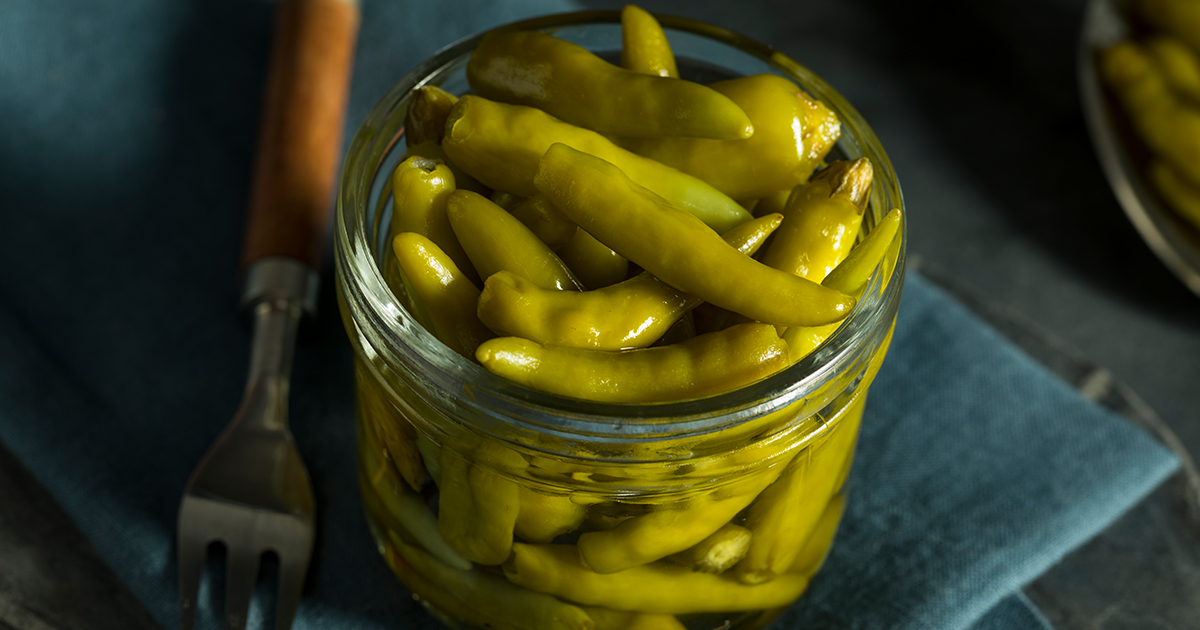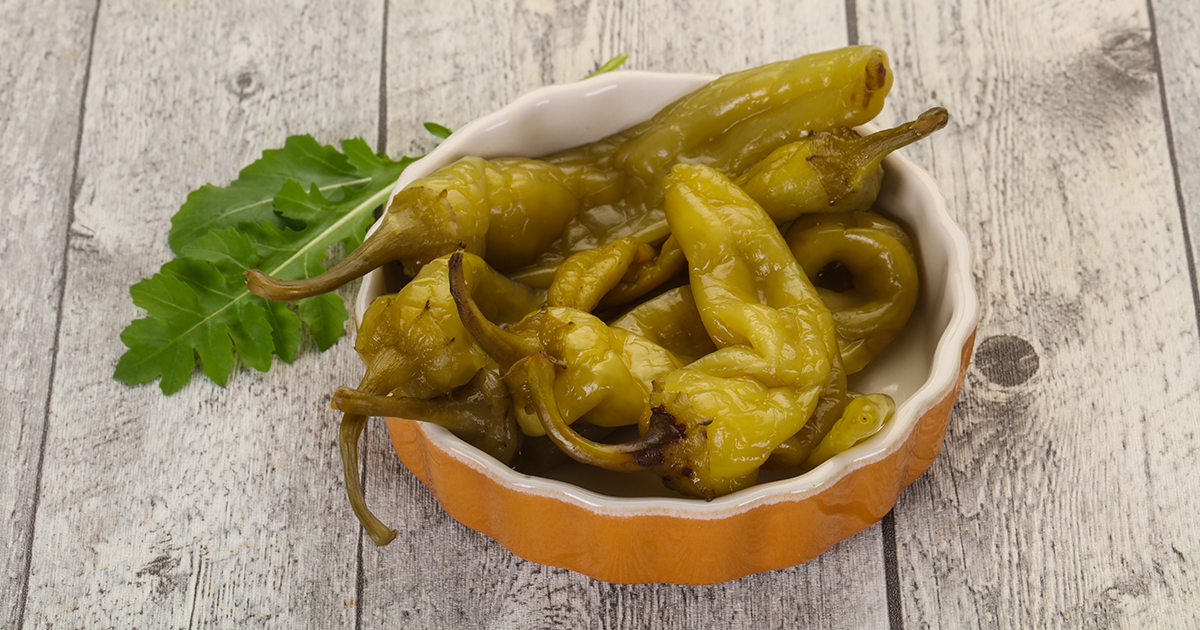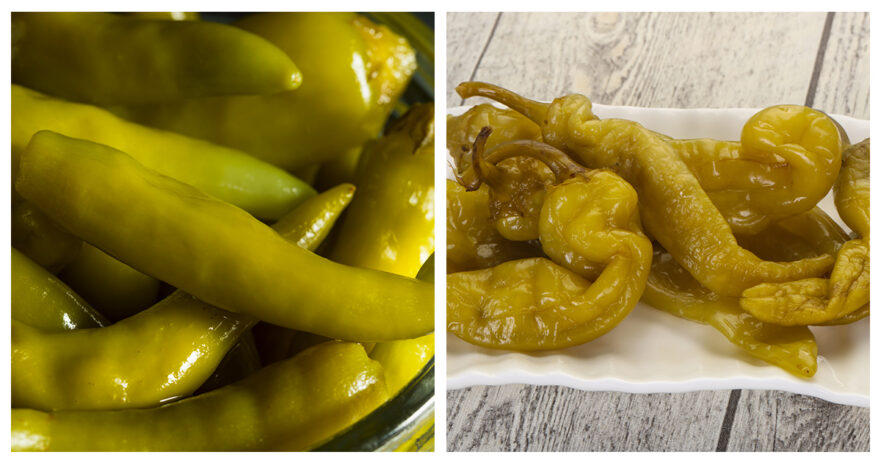When it comes to peppers, the choices are practically endless. The variety of peppers ranges from sweet and mild to hot and spicy. Two peppers that are commonly found in restaurants and grocery stores are sport peppers and pepperoncini. Both peppers have a distinct taste and heat level, but what sets them apart? In this article, we‘ll compare sport peppers vs. pepperoncini, exploring their distinct characteristics and finding out which one is the perfect fit for your recipe.
| Sport pepper | Pepperoncini pepper | |
| SHU | 10,000 - 23,000 | 100 - 500 |
| Median SHU | 16,500 | 300 |
| Flavor | Tangy and slightly sweet, with a moderate heat | Mildly sweet and tangy, with a slight heat |
| Species | Capsicum annuum | Capsicum annuum |
| Origin | Mexico | Italy |
| Uses | Chicago-style hot dogs, sandwiches, pizzas, etc. | Pickling, salads, sandwiches, antipasto, etc. |
Table of contents
What are Sport Peppers?

Sport peppers are small, hot chili peppers commonly used in Chicago-style hot dogs, sandwiches, and other food items. They‘re a variety of Capsicum annuum, and their heat level ranges from 10,000 to 23,000 Scoville Heat Units (SHU), which puts them in the medium to hot range. Sport peppers are typically harvested when they‘re green and then pickled in vinegar and salt, which gives them a tangy and slightly sour taste.
Sport peppers are similar in appearance to serrano peppers, but they’re a little smaller and more pointed. They have a bright green color and a smooth texture. The pepper’s size makes it easy to add a kick of heat to any dish without overpowering it. Sport peppers are also great in salsa and chili.
The tangy and spicy taste of sport peppers makes them a popular condiment for hot dogs, sausages, and sandwiches. They‘re often served on the side or chopped up and added to the food. Due to their pickling process, sport peppers also have a longer shelf life, making them easy to store and use for whenever you need a spicy kick.
What are Pepperoncini?

Pepperoncini, also known as Tuscan peppers, are mild chili peppers with a Scoville rating of only 100 to 500 SHU. They‘re also a variety of Capsicum annuum, and their origin can be traced back to Italy. Pepperoncini peppers are typically pickled in vinegar and salt, making them a tangy and slightly sweet snack.
Pepperoncini peppers have a bright green color when best used, turning to red or yellow when mature, and have a smooth texture. They‘re similar in appearance to banana peppers, but they’re a bit smaller. Pepperoncini peppers are commonly used as a garnish or topping for everything from salads, pizzas, and sandwiches. They can also be stuffed with cheese or other fillings and baked for a tasty appetizer!
The mild heat level of pepperoncini peppers makes them a great choice for people who enjoy just a hint of spice without overpowering the taste of whatever they put in. They add a subtle kick to dishes and help balance out flavors. They‘re also a great source of vitamin C and antioxidants, making them a healthy addition to any meal.
Pepperoncini peppers are also pretty easy to grow at home, making them a popular choice for home gardeners. Grow them in containers or in the ground. Up to you. You can plant in the spring and harvest in the summer months! Growing your own pepperoncini peppers not only provides you with a fresh supply for cooking and snacking, but it can also make for a fun and rewarding gardening project.
What are the Similarities Between Sport Peppers and Pepperoncini?
Sport peppers and pepperoncini have a few similarities that make them popular with people who enjoy spicy food.
Both of these peppers are often pickled in vinegar and salt, which gives them a tangy and sort of sour taste. This makes them great additions to sandwiches, hot dogs, and pizzas.
Another similarity, both peppers have a smooth texture and are easy to chop up and add to, well, everything! They are both great in salsa, and they can be used in a variety of dishes that would benefit from a little bit of heat.
Aside from the fact that both sport peppers and pepperoncini are used in cooking, they‘re often associated with certain regional food specialties. Sport peppers are most commonly found in Chicago-style hot dogs, which are popular street food. Pepperoncini, on the other hand, are commonly used in Italian cuisine. They‘re often used as a part of antipasto platters.
While each of these are most often associated with certain places, they are both easy to find in grocery stores around the world.
What are the Differences Between Sport Peppers and Pepperoncini?
While sport peppers and pepperoncini share do some similarities, they also have very distinct differences that set them apart.
First of all, their heat levels: Sport peppers are definitely hotter than pepperoncini. The former boasts a Scoville rating of 10,000 to 23,000, while the latter only rates 100 to 500 on the same scale.
Secondly, size and appearance: Sport peppers are smaller and thinner than pepperoncini. They start off green and turn red as they mature. Pepperoncini, on the other hand, are longer, thicker, and more curved than sport peppers. They begin as light green and turn yellow or red as they ripen.
Another difference is flavor: Sport peppers have a tangy, slightly sweet taste with a spicy punch. Pepperoncini are milder, with a subtle sweetness and tanginess.
Finally, culinary uses: Sport peppers are commonly used in Chicago-style hot dogs, Italian beef sandwiches, and pizza, while pepperoncini are often found in all sorts of Mediterranean dishes such as salads, sandwiches, and antipasti platters.
FAQ about Sport Peppers and Pepperoncini
What‘s the heat level difference between sport peppers and pepperoncini?
Sport peppers are much hotter than pepperoncini. They have a Scoville rating of 10,000 to 23,000, while pepperoncini only rate 100 to 500 on the same scale.
What are the similarities between sport peppers and pepperoncini?
Both peppers often get pickled in vinegar and salt, creating their signature tang. They both have a smooth texture and are easy to work with. Also, sport peppers and pepperoncini are both good sources of vitamin C and antioxidants, making them a healthy addition to any meal.
What are the culinary uses of sport peppers?
Sport peppers are commonly used in Chicago-style hot dogs, but they can go into any dish that needs a tangy and spicy hit of flavor.
What are the culinary uses of pepperoncini?
Pepperoncini are often found in Mediterranean dishes of all kinds. They‘re commonly used as toppings, but they can also be stuffed with cheese or other fillings and baked.
What‘s the difference in size and appearance between sport peppers and pepperoncini?
Sport peppers are smaller and thinner than pepperoncini, with an olive green skin. Pepperoncini are longer, thicker, and more curved than sport peppers and have a light green color.
What‘s the difference in flavor between sport peppers and pepperoncini?
Both are tangy with a hint of sweetness, but sport peppers are much hotter.
Can sport peppers and pepperoncini be used interchangeably in recipes?
Not particularly. With the difference in heat levels, sport peppers might overwhelm a dish that is meant to be made with pepperoncini.

